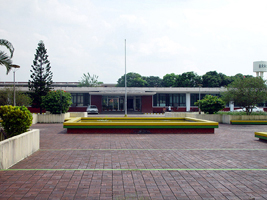Bangladesh Rice Research Institute
Bangladesh Rice Research Institute (BRRI) an autonomous research organisation established in 1970 at Joydebpur, gazipur, for conducting research towards development of rice varieties with desirable characteristics and their management technologies for different ecosystems. The Director General (DG) is the head of the organisation.
In addition to the headquarters and central station at Joydebpur, the institute is supported by 10 regional stations at Barisal, Bhanga, Khulna, Kushtia, Rajshahi, Rangpur, Habiganj, Comilla, Sonagazi and Rangamati.

There are 18 research divisions to take care of different disciplines: Plant Breeding, Genetic Resources and Seed, Biotechnology, Grain Quality and Nutrition, Agronomy, Soil Science, Irrigation and Water Management, Plant Physiology, Entomology, Plant Pathology, Rice Farming Systems, Agricultural Statistics, Agricultural Economics, Farm Management, Farm Machinery and Post Harvest Technology, Workshop Machinery and Maintenance, and Adaptive Research and Training. Research activities are operated under seven programme areas which include varietal development, crop-soil-water management, pest management, rice-based farming systems, farm mechanization, socio-economics and policy, and technology transfer. The overall management of the institute is vested on a 13-member Board of Management chaired by the Director General. The DG is assisted by two directors, one is for research and the other for administration and finance.
The major achievements of the Bangladesh Rice Research Institute (BRRI) has been the development of 37 high yielding modern variety (MV) rice strains adaptable to different ecosystems since its establishment. Thirteen of these MV rices are suitable for cultivation in both the Boro and Aush seasons, seven in the Boro season five in the Aus season, and twelve in the transplanted Aman (T Aman) season. With appropriate management, and under favourable soil conditions, these MV rices may yield 5-6 m tons/ha in the Boro, 3-4 m tons/ha in the Aus, and 4-5 m tons/ha in the T Aman seasons.
During the early years of research, BRRI followed the International Rice Research Institute (IRRI) in developing semi-dwarf photoperiod-insensitive varieties. Over time, BRRI scientists deviated from the IRRI concept of dwarfism for high yield, and restructured the IR8 plant type to suit local agroecological conditions. Intermediate-height plants with relatively short growth cycles and mild photoperiod-sensitivity were developed to suit the local agroecological conditions and meet the socioeconomic demand of farmers.
MV rices of BRRI presently cover 90% of the Boro (winter rice), 25-30% of the Aus (summer rice), and 50-55% of the T Aman (wet season rice) areas of Bangladesh. These varieties together cover 56% of the total rice area and account for about 74% of the total annual rice production of the country. BRRI MV rices and modern rice production technologies played the key role in boosting annual rice production in Bangladesh from 9.93 million m tons of clean rice in 1972-73 to nearly 19 million m tons of clean rice at present.
BRRI cereal chemists regularly evaluate rice grain quality in terms of taste, cooking quality, milling outturn, aroma, protein and amylase contents etc, helping plant breeders develop varieties with desirable grain quality. About 7,500 germplasms, of which nearly 5,000 are local have been collected and preserved by BRRI plant breeders. Recently, sufficient, thrust has been given on hybrid rice development and production technology.
BRRI now has 134 scientists and 344 supporting staff working at Joydebpur (HQ) and its 9 regional stations. The institute has active research collaboration schemes with different national and international organisations. [M Abdul Hamid Miah]
See also bangladesh agricultural research institute; rice.
